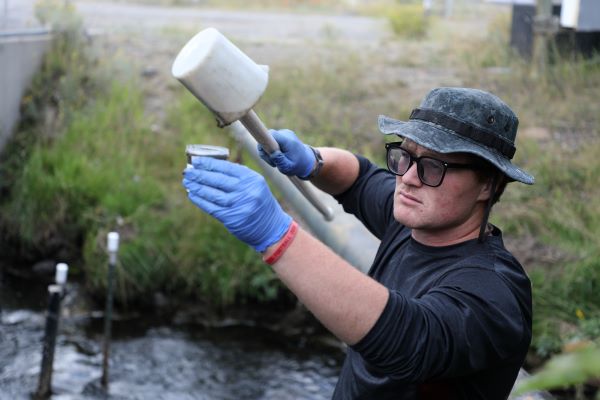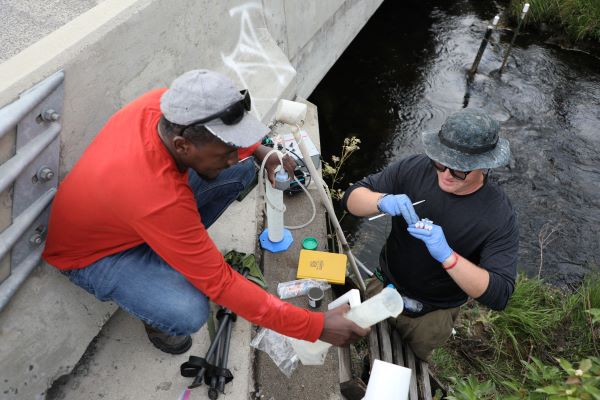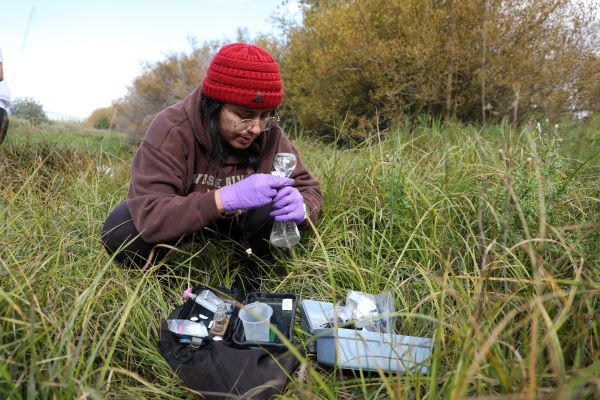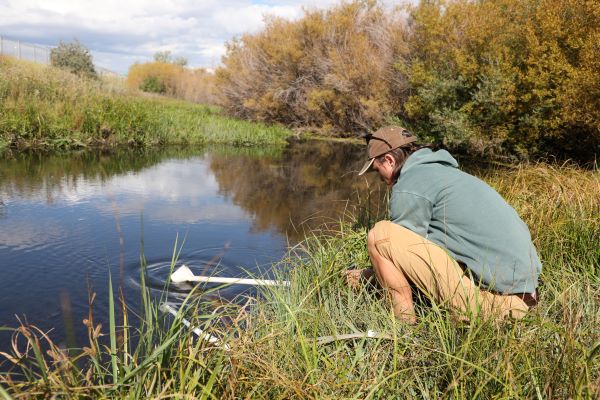LEGEND Studies Biogeochemistry in the Recovering Clark Fork Ecosystem
The ecological restoration of Silver Bow Creek and the Clark Fork River, underway since the 1980s, is visible at the macrolevel.

After more than a century of degradation from mining, Silver Bow Creek is beginning to recover. Songbirds flit in willow branches, and fish sip mayflies from the surface. Although the creek shows signs of recovery, the health of the creek’s microbial communities is unknown. Montana Tech researchers are using paired environmental DNA and comprehensive geochemical survey techniques to better understand these complex communities for insight into the health of the watershed as a whole.
The project is spearheaded by Dr. Alysia Cox, Associate Professor of Environmental Chemistry, through the Laboratory Exploring Geobiochemical Engineering and Natural Dynamics (LEGEND) at Montana Tech. Dr. Cox founded the lab in 2015.

“Our lab investigates biotic and abiotic processes happening in the environment at a given time and place under the set of conditions present, as well as developing a framework for how life has evolved in coordination with Earth in the past. Our interest in our local creeks and river stems from our desire to create an ecosystem health metric based on microbes and geochemistry that can be applied locally as well as to other impacted rivers globally. We have an experiment in remediation and restoration happening right on our doorstep,” Dr. Cox said.

Paul Helfrich (M.S. Ecological Restoration, ’21) is a student in the Earth Science and Engineering Ph.D. program. Over Labor Day weekend, he and other students could be seen on the banks of Silver Bow Creek, scooping water and sediment from the creek and other sites in the Clark Fork watershed for biogeochemical analysis. The LEGEND team samples 17 sites from Drummond to Thompson Park to bracket the center of historic contamination and other anthropogenic inputs. The process is then repeated every three months. The samples are taken back to the lab where the team extracts DNA from filters and sediments to collect environmental DNA. Environmental DNA is a method to determine which species are present in an ecosystem by analyzing the DNA shed by the organisms living in the area.

Because each species has unique DNA, the samples contain information on a variety of organisms living in the creek.
“By studying the encoded functional potential of an organism, you can understand not only what that organism is, but also what it has the potential to do,” Helfrich said.
The DNA analysis of samples taken from Silver Bow Creek have unlocked a trove of information.
“The samples we’ve been working through have shown that the microbial communities in the creek are extremely rich and they have immense functional potential to shape the ecosystem around them and clearly continue to do so,” Helfrich said.
In addition to taking in samples of environmental DNA, the LEGEND researchers conduct comprehensive geochemical surveys of their investigation sites. The team records information about aqueous geochemistry, including measurements ranging from pH to metal concentrations. They use these data to predict chemical speciation in the water, providing a complete geochemical “snapshot” of the creek at each sampling site. After more than eight years of sampling, a more complete picture has begun to emerge of how conditions impact the species in the stream.
“Our goal is to begin to connect the information we see in the metagenomes with the environmental conditions of the river,” Helfrich said. “The amount of information that is held in these sediments and on these filters goes so deep. The river is a dynamic place that has immense potential in helping us understand the ongoing recovering state of Silver Bow Creek and the Clark Fork. The ultimate goal of the research is to aid in the restoration of the area by providing a comprehensive microbiological–geochemical record of the evolving status of the area.
“Microorganisms are extremely abundant and active components of all ecosystems,” Helfrich noted. “Our understanding of microorganisms has really grown over the past few decades. What we understand now is that they are the drivers of extremely important processes, including the flow of nitrogen and carbon through ecosystems. It’s human nature to think these things are so tiny that they don’t make much of a
difference, but the truth is that not only do they make a huge difference, they are the foundation for all ecosystems.”
As the team’s log of data grows, so do the potential questions the research group could focus on. How do emerging contaminants impact the microbes in the creek and river? How do added nutrients impact the flow of energy through the system?
“We have barely scratched the surface of what can be learned from our samples,” Helfrich noted.
For more information about the LEGEND, visit https://mtechlegend.weebly.com/.